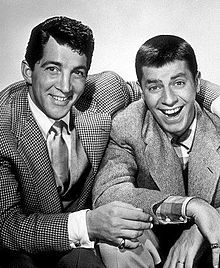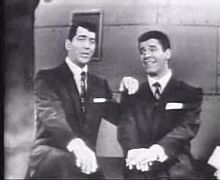- Martin and Lewis
-
This article is about the American comedy duo Martin and Lewis. For the British-born humorist, see Martin Lewis (humorist). For other uses of the name, see Martin Lewis (disambiguation).
Martin and Lewis were an American comedy team, comprising singer Dean Martin (as the "straight man") and comedian Jerry Lewis as the comedic "foil". The pair first met in 1945; their debut as a duo occurred at Atlantic City's 500 Club on July 24/25, 1946.
Before they teamed up Martin was a nightclub singer, while Lewis did a comedy act in which he lip-synched to records. As a team, they worked in nightclubs, on radio (starting in 1949) and in television and films. In the team's later years, it was no longer billed by the two men's surnames alone, as in their early radio work, but by their full names: "Dean Martin and Jerry Lewis." These separate identities helped them launch successful solo careers after the team's dissolution.
Contents
Nightclubs
In 1945, Martin (born Dino Paul Crocetti in Steubenville, Ohio) met a young comic named Jerry Lewis (né Joseph Levitch, from Newark, N.J.) at the Glass Hat Club in New York, where both men were performing.[1] Martin and Lewis' official debut together occurred at Atlantic City's 500 Club on July 24, 1946, and they were not a hit. The owner, Skinny D'Amato, warned them that if they didn't come up with a better act for their second show later that same night, they would be fired. Huddling together out in the alley behind the club, Lewis and Martin agreed to go for broke, to throw out the pre-scripted gags that hadn't worked and to basically just improvise their way through the act. Dean sang some songs, and Jerry came out dressed as a busboy, dropping plates and more or less making a shambles of both Martin's performance and the club's sense of decorum. They did slapstick, reeled off old vaudeville jokes, and did whatever else popped into their heads at the moment. This time, the audience doubled over in laughter.
Their success at the 500 led to a series of well-paying engagements up and down the Eastern seaboard, culminating with a triumphant run at New York's Copacabana.[citation needed] Club patrons were convulsed by the act, which consisted primarily of Lewis interrupting and heckling Martin while he was trying to sing, and ultimately the two of them chasing each other around the stage and having as much fun as possible. The secret, they have both said[citation needed], is that they essentially ignored the audience and played to one another.
Radio, television, and films
An NBC radio series commenced in 1949; it lasted until 1953. Martin and Lewis made key appearance on the first Ed Sullivan show ("Toast of the Town") in June 1948 (photographs and schedules in Library of Congress confirm this), although they may have appeared on TV earlier on "Hour Glass",the first TV variety show which aired from May 1946 - March 1947, during the time the duo first paired up formally. On October 3, 1948, the team were stars of the television debut of the NBC live television variety show Welcome Aboard sponsored by Admiral, manufacturers of TV sets, and were also featured on the second show of October 10, 1948 (kinescope survives of this live TV broadcast in UCLA archives). On April 3, 1949 they debuted on their TV version of their "Martin & Lewis" radio show on the NBC-TV network, with guest Bob Hope, with their inaugural program drawing lackluster reviews in the April 30, 1949 issue of Billboard magazine.
Also in 1949, Martin and Lewis were signed by Paramount producer Hal Wallis as comedy relief for the film My Friend Irma.
Martin was thrilled to be out of New York City, a place he had developed a lifelong hatred for.[attribution needed] He liked the fact that California, because of its earthquakes, had few tall buildings. Suffering as he did from claustrophobia, Martin almost never used elevators, and having to climb multiple flights of stairs in Manhattan's skyscrapers was not his idea of fun.
Their agent, Abby Greshler, negotiated for them one of Hollywood's best deals: although they received only a modest $75,000 between them for their films with Wallis, Martin and Lewis were free to do one outside film a year, which they would co-produce through their own York Productions: their first starring feature was the independently-produced At War with the Army (1950). They also had complete control of their club, records, radio and television appearances, and it was through these endeavors that Martin and Lewis earned millions of dollars. They made regular appearances on NBC's Colgate Comedy Hour during the 1950s.
Although there had been a number of hugely successful film teams before, Martin and Lewis were a new kind of team. The fun they had together set them apart from everything else being done at the time. Both were talented entertainers, but the fact that they were such good friends on and off stage took their act to a new level.
Martin and Lewis were the hottest act in America during the early '50s, but the pace and the pressure took their toll. Dean usually had the thankless job of the straight man, and his singing had yet to develop into his unique style of his later years. The critics praised Lewis, and while they admitted that Martin was the best partner he could have, most of them claimed that Lewis was the real talent of the team and could succeed with anyone.[citation needed] It is worth noting that Lewis always praised his partner, and while he appreciated the attention he was getting, he has always said with complete conviction that the act would never have worked without Martin.[citation needed] In the book Dean & Me Lewis calls Martin one of the great comic geniuses of all time.
After five years at Paramount Pictures, Dean Martin was becoming tired of scripts limiting him to colorless romantic leads while the stories centered on the antics of Jerry Lewis. Martin also noticed that Lewis was playing comedy scenes for pathos and greed and staging more of the action himself, having lost vision of what their comedy team-up was all about in the first place.[citation needed] The last straw came when Look gave Martin and Lewis a cover photo—and cropped Martin out of the picture, humiliating Martin. Martin dutifully fulfilled the rest of his movie contract, but put less and less enthusiasm into his work and becoming increasingly disillusioned about his partnership with Lewis, leading to escalating arguments with Lewis. The two finally could not possibly work together, especially when Martin angrily told his partner that he was "nothing to me but a fucking dollar sign."[2] Martin left the act at his first opportunity, on July 25, 1956 (10 years to the day after the first official teaming, even though they performed together before). Hollywood or Bust was their final film released in late 1956.
After the split
Martin's career arguably reached new heights after the team split up, as a recording artist for the Capitol and Reprise labels, as a movie actor (Rio Bravo, The Young Lions and the Matt Helm series), as a member of Frank Sinatra's Rat Pack (Ocean's 11, Sergeants 3, Robin and the 7 Hoods), and with his own hugely successful 1960s-'70s television variety series, The Dean Martin Show. Lewis made a succession of commercially successful films on his own (The Nutty Professor, The Bellboy), at one point becoming Paramount Picture's biggest star.
The two men reconciled privately in the later years of Martin's life. In 1976, Martin made a surprise appearance on Lewis's annual Labor Day telethon for the Muscular Dystrophy Association, orchestrated by mutual friend Frank Sinatra.
Another source[who?] claims that contrary to belief, the 1976 MDA telethon was not the first reconciliation of the legendary comedy team. In 1960, four years after they split, Martin and Lewis briefly reunited. Both were performing their own separate acts at the Sands Hotel in Las Vegas, a club they frequently played while they were together. Lewis caught Martin's closing act and Martin introduced his former partner to the audience, bringing him on stage. For about 15 minutes, they joked a bit and sang a duet of "Come Back to Me". However, the reunion was never duplicated. Later in 1960, when Lewis was rushing to finish The Bellboy and too exhausted to perform his stage act, Martin generously replaced him.
In 1987, when Dean's son Dean Paul Martin was killed in a plane crash, Jerry attended the funeral unannounced. He did not walk up to Dean, for he did not want any reporters to catch them together.[citation needed] Later when Dean found out about it, he called Jerry and talked to him for about an hour.[citation needed] Finally in 1989, the two reunited for the last time together at Bally's Hotel and Casino in Las Vegas where Dean was doing a week of shows. The occasion was Dean's 72nd birthday. Lewis presented him with a birthday cake, thanked him for all the years he gave joy to the world, and finally joked, "Why we broke up, I'll never know."[citation needed] This would be the last public reunion of the duo before Martin's death in 1995.
The animosity between Martin and Lewis after the split was legendary, but Lewis published an affectionate memoir of his partnership with Martin called Dean and Me — A Love Story in 2005.
Biopic
Martin and Lewis is a 2002 CBS television movie which portrays the lives of Dean Martin and Jerry Lewis. Directed by John Gray and starred Jeremy Northam as Martin and Sean Hayes as Lewis, the film depicts the years from 1946 to 1956, where they first teamed up, their separate lives and their breakup.
Filmography
Year Movie Jerry Lewis Role Dean Martin Role Notes 1949 My Friend Irma Seymour Steve Laird Film Debut 1950 My Friend Irma Goes West Seymour Steve Laird 1950 At War with the Army PFC Alvin Korwin Sgt Victor Puccinelli 1951 That's My Boy 'Junior' Jackson Bill Baker 1952 Sailor Beware Melvin Jones Al Crowthers 1952 Jumping Jacks Hap Smith Chick Allen 1952 Road to Bali 'Woman' in Lala's Dream Man in Lala's Dream Cameo; first appearance in Technicolor 1953 The Stooge Theodore Rogers Bill Miller 1953 Scared Stiff Myron Mertz Larry Todd 1953 The Caddy Harvey Miller, Jr. Joe Anthony 1953 Money from Home Virgil Yokum Herman "Honey Talk" Nelson Filmed in 3-D. 1954 Living It Up Homer Flagg Dr. Steve Harris 1954 3 Ring Circus Jerome F. Hotchkiss Pete Nelson Re-released in 1978 as 'Jerrico The Wonder Clown' 1955 You're Never Too Young Wilbur Hoolick Bob Miles 1955 Artists and Models Eugene Fullstack Rick Todd 1956 Pardners Wade Kingsley Sr/Wade Kingsley Jr Slim Mosley Sr/Slim Mosley Jr 1956 Hollywood or Bust Malcolm Smith Steve Wiley Last film together See also
- Old time radio
References
Further reading
- The Jerry Lewis Films by James L. Neibaur and Ted Okuda. Jefferson, SC: McFarland, 1994, ISBN 0-8995-0961-4
- Everybody Loves Somebody Sometime (Especially Himself): The Story of Dean Martin and Jerry Lewis by Arthur Marx, New York, NY: Hawthorn Books, 1974, ISBN 978-080152430
External links
Categories:- American comedians
- Comedy duos
- 1946 establishments
- 1956 disestablishments
- 1940s American radio programs
- 1950s American radio programs
Wikimedia Foundation. 2010.


